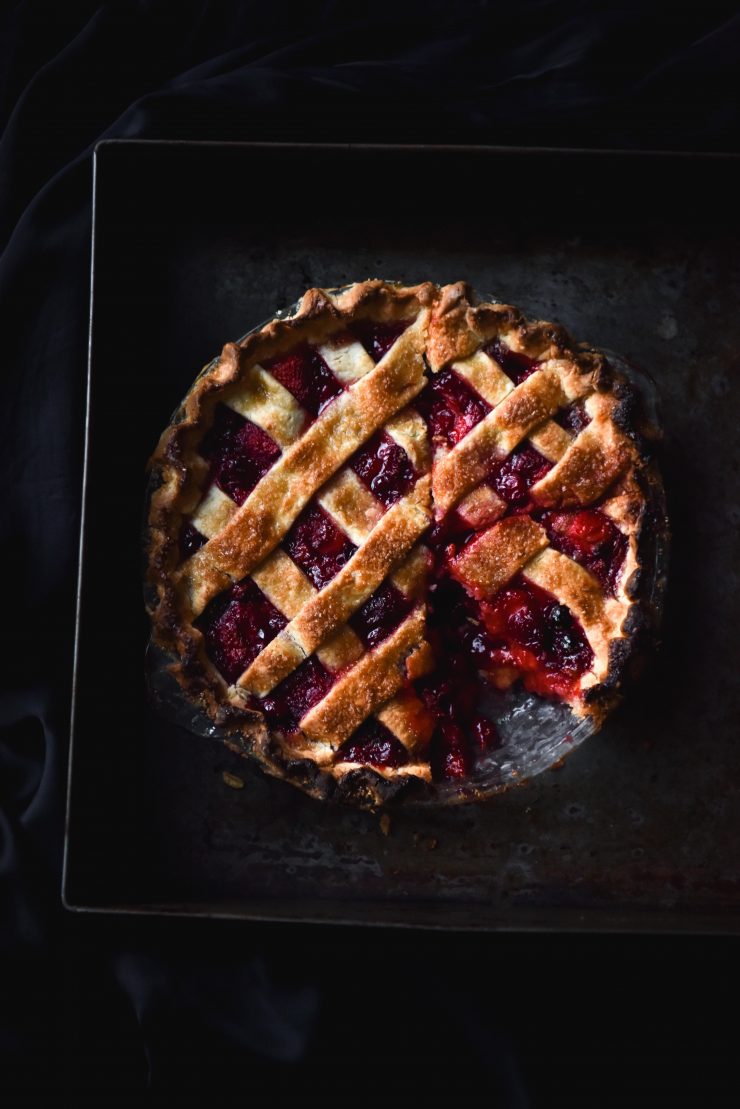
You may have noticed recently that I’ve been into pies. I made a FODMAP friendly pumpkin pie, and I contributed some gluten free fruit free mince pies to The Guardian. Two pie recipes = very into pies. Hadn’t you heard?
A big part of this recent emotional attachment to pie is my gluten free pastry recipe. The pastry is easy to make with easily acquired supermarket ingredients. Your guests won’t even know it’s gluten free (speaking from experience) so they won’t politely eat around it like they normally do (speaking from experience).

Gluten free strawberry pie
So, let’s dive in to this gluten free strawberry pie recipe. It is gluten free, FODMAP friendly, nut free and delicious. The pastry can be made a day ahead (keep it in the fridge) or even further ahead (keep in the freezer.) It is the perfect way to use up the bounty of the season – if you can eat apples, it would make a delicious apple pie in the colder months.
As for the pie itself? It’s SUPER juicy. Personally, I like nothing more than excessive amounts of strawberry juices coming out of my pie. If that’s not for you, however, I HIGHLY recommend reading this article about controlling the juices in your pie. Takeaway messages? A)That you can partially cook your berries and strain off the excess liquid and B) that how juicy your pie becomes is 90% dependent on how juicy your fruit is. It’s luck of the draw, my friends.
Gluten free strawberry pie tips
As mentioned, these flours can all be acquired at the supermarket. However, I find that supermarket rice flour can have a distinctly rice-like taste. For best results, I HIGHLY recommend sourcing the rice flour from a bulk food store or health food store.
I recently trialled this recipe using fruit that was frozen from fresh. I recommend defrosting it until warmed through in a saucepan, then straining the excess liquid. You could also blind bake bake as an insurance policy (see the last dot point in this section)
If you can only find brown rice flour, you can substitute it for the white rice flour. They perform a little differently, but in this case that might be beneficial. I find brown rice flour a little more thirsty than white, which may help in keeping the bottom of the pie solid.
Use gluten free cornflour to keep this recipe gluten free. I don’t recommend omitting it – it gels all the liquid from the strawberries together.
I always like to link a Bon Appetit Youtube vid. This one is about pie making.
According to this link, if you’d like to eat the pie shortly after cooking it, you might prefer using tapioca as a thickener as opposed to cornflour.
If you really dislike a soggy bottomed pie (something fruit pies are prone to) you can blind bake the base before adding the fruit. There are instructions in the pumpkin pie recipe. However, as a quick refresher, just remember to weight the pastry down with pie weights in baking paper (I have a jar of dry chickpeas specifically for this purpose.) If you don’t weight the pastry down it will puff and disfigure. After par baking, give the pastry a good brush with egg wash and return to the oven for 2 or so minutes. This will seal the base and help keep it firm once you add the fruit.

Working with gluten free pastry
Make sure you give the freshly made pastry enough time in the fridge. It should be a firm brick – no wobbles.
When you’re pressing the fresh pastry ball into the beeswax wrap, try to make it into a circle shape. This will make it easier to roll out into a circle later.
Liberal tapioca flour is the key to success here. Using rice flour for dusting will add extra grit and dryness, while using sticky rice flour will add too much gluey-ness. Sticky rice flour is used to make mochi, if that gives you any idea. Stick to tapioca, and make sure you have plenty of it on hand.
If the pastry is too cold, it will constantly crack around the edges as you attempt to roll it. Leave it on the bench to warm up a little before continuing.
If it’s too warm, it will be soft, extremely pliable, and might even seep butter. You know the answer: chuck it in the fridge or freezer to firm up. You’ll get a sense pretty quickly of what the right temperature is for the dough, so don’t worry too much.
The aim of the game is to keep as many butter chunks (aka flaky pastry) in the pastry as possible. Refrigerate the dough whenever you sense said chunks might be in jeopardy.
Don’t feel like you need to use all of the pastry. You can use the cut offs for mini galettes so don’t overstuff it for no reason.
Gluten free pastry is not nearly as stretchy as regular pastry. Be prepared to patch up any tears with your fingers. Nothing to panic about.
As I’ve previously discussed, I highly recommend full fat sour cream for this recipe. I’ve yet to find a full fat lactose free sour cream (only ‘light’) but the fat to water ratio is super important for a flaky pastry.
If you’re starting to get a little fancy and want to experiment with different flours, see my gluten free flour guide.
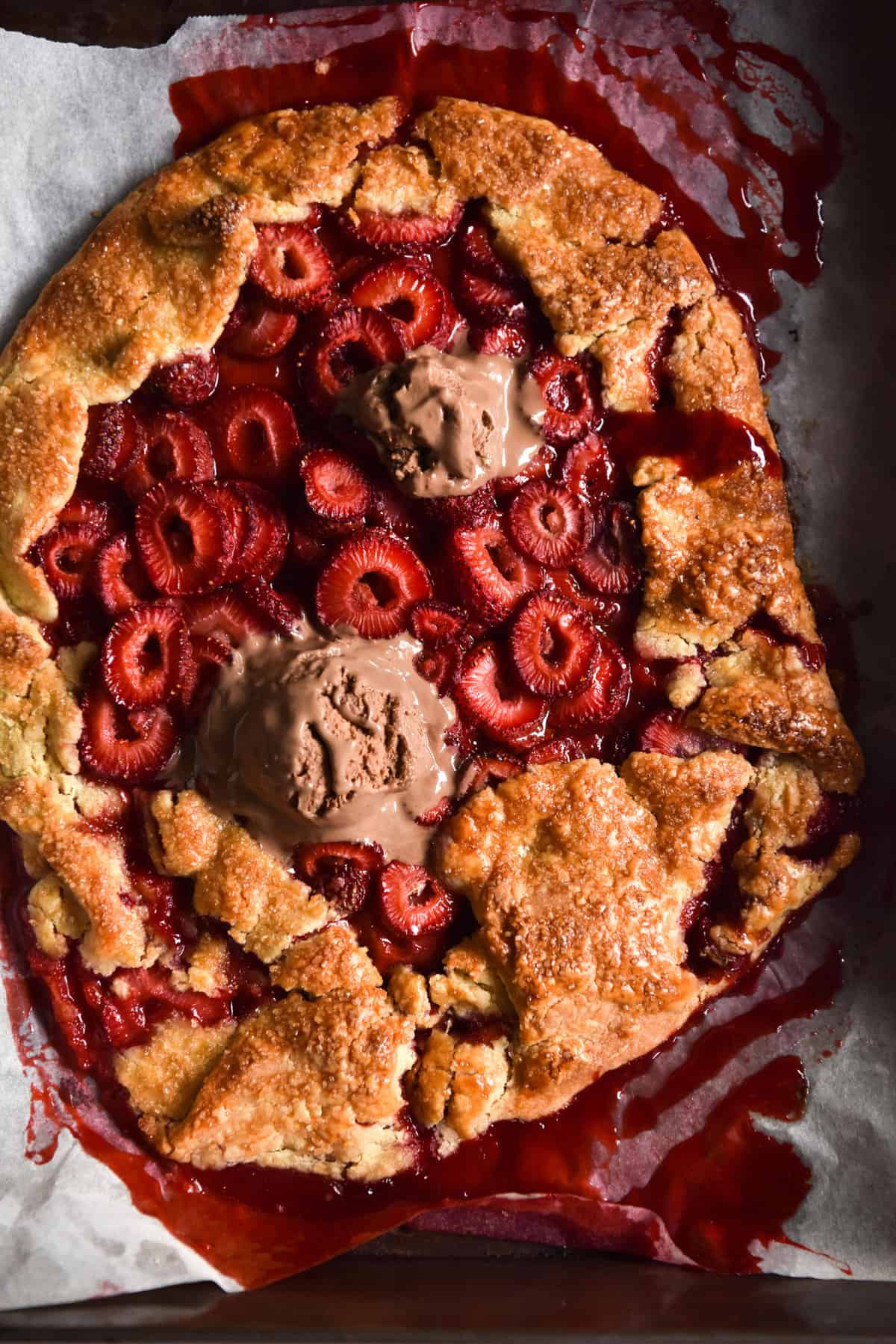
FODMAP notes for your gluten free strawberry pie
- Yes, there is full fat sour cream in the pastry. 200g of it in total. 40g serves are deemed lactose friendly by Monash, and if you divide this pie into 8 slices (which will be quite generous) you’ll only be eating 25g worth. I’m working on a vegan version, but for now this level of lactose shouldn’t be an issue.
- As of 2022, Monash has downgraded the FODMAP threshold for strawberries. Super depressing, I know. 5 berries or 65g per serve is now considered a FODMAP friendly amount. This means that one serve of the pie would contain 125g of strawberry. If you are fine with berries and have no issues, amazing! Proceed as usual. If you have had issues with them, consider making this into a rhubarb and strawberry pie, using 500g rhubarb and 500g strawberries. That will put you smack bang in the acceptable range for strawberries.
- You may need to experiment with the sugar content if you do so – rhubarb can be quite tart and needs sugar to balance it out.
- That’s all there is! Sugar and butter are FODMAP friendly as hell.
Substitution options
You could use any fruit that is seasonal in place of the strawberries. While they’re aren’t too many FODMAP friendly fruit options, there are PLENTY of options if you don’t need the pie to be FODMAP. Apples, pears, blueberries, cherries, apricots or peaches (this makes me sad just typing it.)
You could experiment with adding a little brown sugar to the berry mix. It will add a more caramel depth of flavour. Just remember to sub out a little white sugar in it’s place.
In a pinch, you can substitute the white rice flour with brown rice flour if it’s all you have. I prefer the white rice flour option, but it is possible.
Neither the tapioca flour nor sticky rice flour are substitutable. You can buy them at the supermarket, so there should be no reason to.
I haven’t tried this pastry recipe with vegan butter, although I can’t see why it would be an issue.
Another thing I haven’t tried? Any sort of dairy free substitute for the sour cream. You’ll be doing your own experiment if you choose to try this out.
Lime juice can be used in place of lemon, and vanilla can be omitted for another flavour. Personally I prefer a classic strawberry flavour to a spiced one, but you can add spices if that’s your thing.
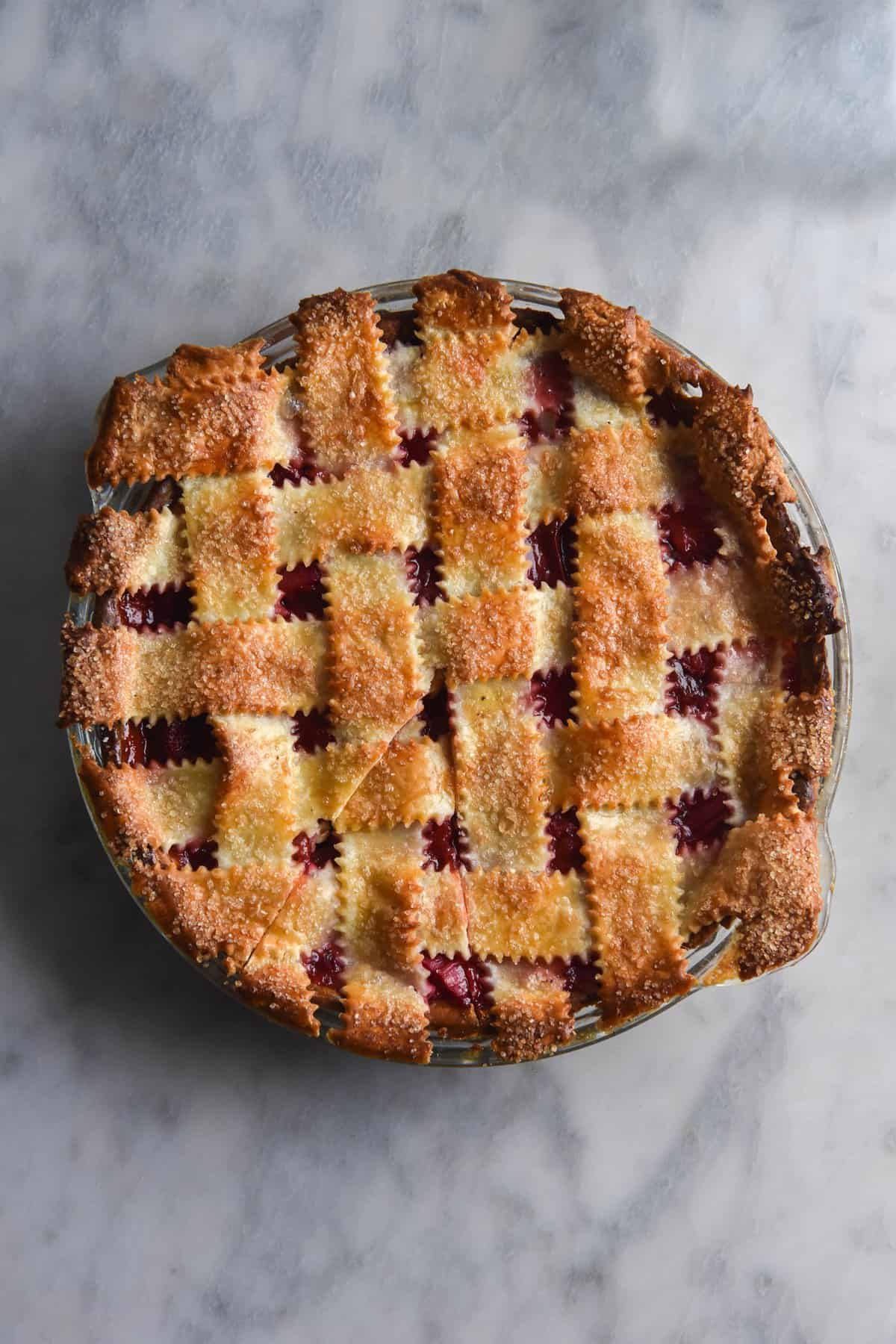
How to make a gluten free strawberry galette
So you want to make a gluten free strawberry galette instead? Follow these simple instructions.
- Make half the amount of pastry. For the measurements of a half batch, see this pumpkin pie post. I have faith in your mathematic skills and and abilities, however.
- Follow the pastry making instructions, but roll the single piece of pastry out onto a sheet of well floured baking paper in a circular or oval shape.
- Place the strawberries (I used about 550g, so roughly half) in a bowl with 2-3 tablespoons of caster sugar, a pinch of salt and a squeeze of lime juice. Mix well. This would also be a good time to add some cornflour, but I obviously forgot.
- Follow these instructions for lifting the edges up to create the galette shape.
- Brush the pastry with egg wash and sprinkle with some coarse sugar (Demerara or Turbinado)
- Place the galette in the oven and cook for 20-30 minutes. Done!
Things to note:
- Galettes leak. Particularly strawberry ones. Use a rimmed baking sheet for this galette.
- As with most baked strawberry things, this galette is much easier to eat when completely cooled.
FODMAP update
Monash have recently introduced a threshold for strawberries, which is !rude! They used to be ‘eat according to appetite’ whereas now a FODMAP friendly serving is 65g. If you have previously eaten large quantities strawberries with no issues, then you don’t need to change anything. If they have given you issues, I recommend using 500g of strawberries and 500g of rhubarb in this pie. You may need to add a little extra sugar to the fruit mixture to compensate for the tartness of the rhubarb.
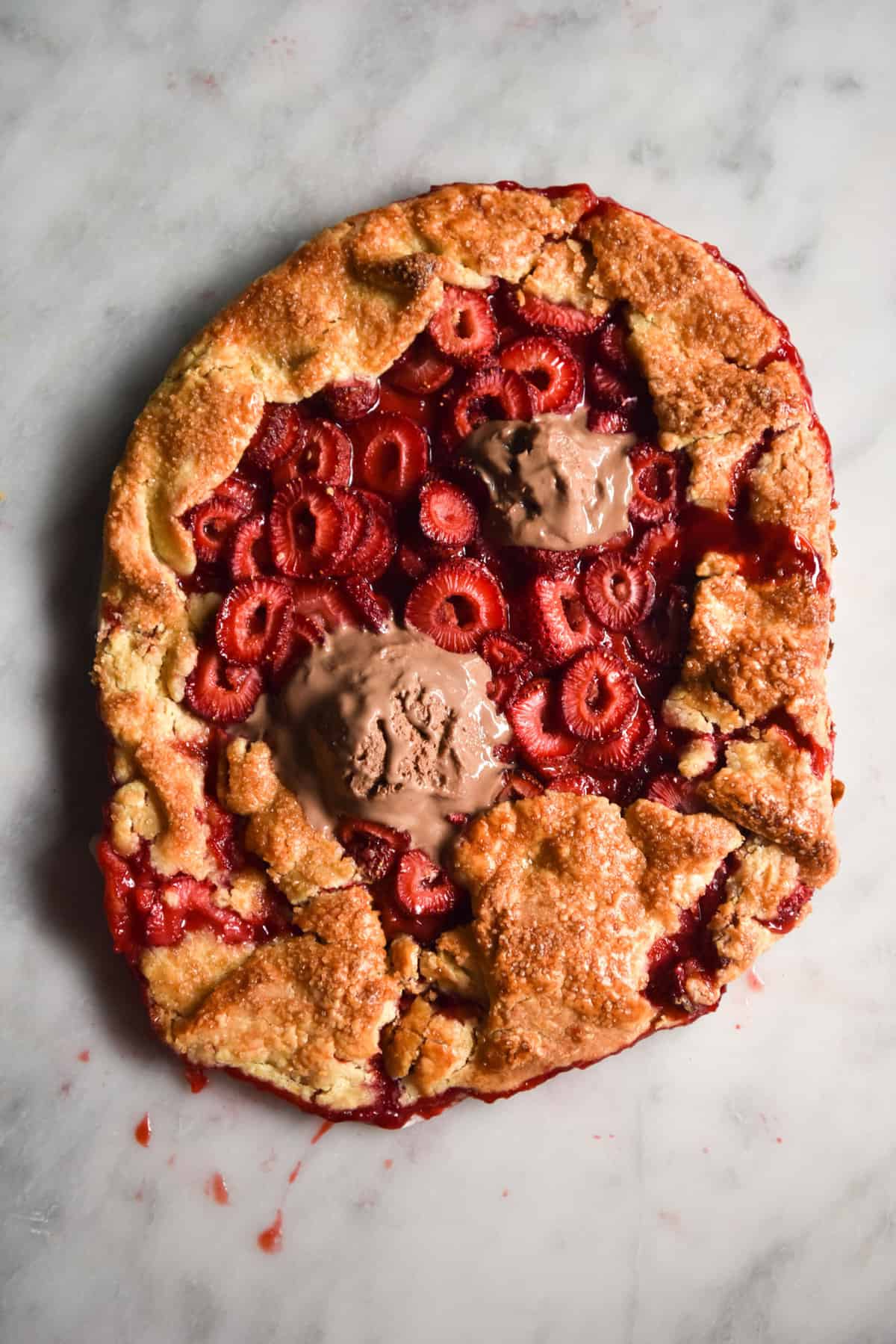
More gluten free dessert recipes
- The gluten free croissants from Intolerance Friendly Kitchen
- Easy chocolate cake without xanthan gum
- Lemon drizzle cake with a single flour (xanthan gum free)
- This grain free chocolate cobbler without eggs
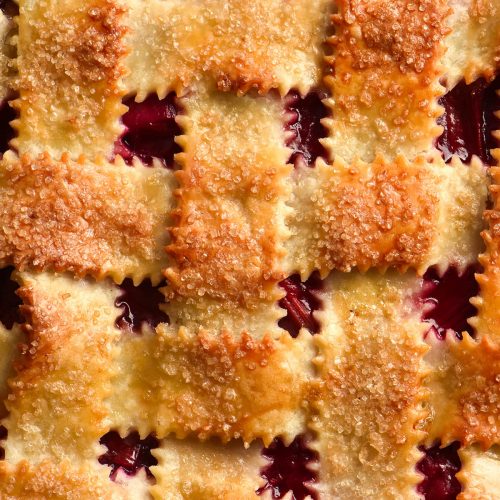
Gluten free strawberry pie
Ingredients
For the pastry
- 2 cups (260g) fine white rice flour
- 1/2 cup (50g) tapioca flour
- 1/2 cup (50g) sticky (or glutinous) rice flour
- 4 tablespoons caster sugar
- 200 g cold butter
- 200 g cold full fat sour cream
- Cold vodka (a teaspoon at a time, to bring the dough together)
For the strawberry filling
- 1 kg strawberries hulled and halved or quartered
- 3/4 cup (150g) caster sugar
- 1 tablespoon fresh lemon juice
- Pinch of fine salt
- 1-2 teaspoons vanilla bean paste
- 1/4 cup gluten free cornflour
TO FINISH:
- Eggwash of 1 egg to brush the pie
- Granulated sugar to sprinkle on top (optional)
Instructions
TO MAKE THE PASTRY:
- Start by ensuring that all your liquid ingredients are super cold. Put the butter and sour cream in the freezer, and put ice in your water ahead of using it.
- Mix the flours, sugar and salt together in a large mixing bowl. Add the cubes of cold butter and coat them with the flour mix. Now, use your fingertips to gently rub the butter into the flour mixture. At first it will be slow and difficult, but gradually you’ll melt the butter with the heat of your hands and it will start to be more flexible. You don’t want to completely melt the butter – just rub it into the flour in little sheets. This is what makes the pastry puffy and flaky.
- Think of the hand motion as being the same as the one you make to signal someone is rich. Use your thumbs to push the butter up and back into the bowl. I’ve linked a couple of Youtube tutorials if you’re more of a visual learner.
- Once the butter has been rubbed into the flour mixture, it should look a bit like sand that had gotten a little wet.
- Next, add the sour cream and use a spoon to agitate the mixture – distribute the sour cream without roughly mixing. Once most of the sour cream has been incorporated, use your hands to gently bring the dough together without smushing the butter bits.
- Adding liquid here depends entirely on what your dough looks like at this point. If it comes together in a smooth-ish ball with no dry spots, don’t add any liquid. If it is still dry and crumbly, add the ice vodka, a teaspoon at a time. Use your hands to bring the dough together between each teaspoon, and stop as soon as the dough is smooth.
- Divide the dough into 2 balls (one for the base and one for the top.) Tightly wrap the dough in a beeswax wrap (I don’t feel comfortable recommending cling film anymore) press into a rough circle, and place in the fridge for 20-30 minutes.
TO PLACE THE PASTRY IN THE PIE PLATE:
- Generously grease the pie plate with butter and set aside.
- Liberally flour a piece of baking paper with tapioca flour on a dry work surface. Place 1 piece of the pastry dough in the centre of the paper and flour it on the top too. I can’t stress this enough – use plenty of tapioca flour. It’s the only way you’ll come out with your sanity intact.
- Gently roll the dough out, stopping every couple of rolls to flour both sides of the dough. ‘Turn’ the dough regularly (pick it up and flip it over) to prevent it from sticking. Once the dough gets too big to turn, take another piece of well floured baking paper and place it atop the dough. Working quickly, lift the dough up and flip it onto the newer piece of baking paper. Then you can continue rolling.
- If at any point the dough becomes soft and hard to work with, place it flat in the fridge or freezer for a few minutes.
- Once you have rolled it out to a couple of sizes larger than the pie plate, place it flat in the freezer for about 5 minutes to get ready for the pie plate.Gluten free pastry is pretty sensitive, so be ready to patch up tears with your hands.
- Lay the pastry flat on a working surface like a table so you have a bit of space underneath for your hands. Place the pie plate gently in the centre of the pastry dough in whatever position maximises pastry overhang.
- Use one hand to pull a corner of the baking paper towards you, and place the other directly underneath the centre of the pie dish. As you pull the pastry off the table, your other hand will push the pastry into the pie dish, after which you will quickly flip the dish, letting the pastry fall into it.
- Don’t stretch the pastry into the dish – be generous with letting it fall into the dish. Patch up any tears as necessary, and then trim excessive overhang, redistributing it to places that may have none.
- Once the whole pie has equal overhang, fold it into the back of the pie dish to create a little wall of pastry. Do this the whole way around. Place the pie base in the fridge while we finish off the rest of the pie, and don’t clean up the tapioca flour space just yet – we have to roll out the top.
TO FINISH THE PIE:
- Combine all the ingredients for the strawberries in a large mixing bowl, and stir well to combine. Set aside to macerate.
- Place the second piece of pastry atop the tapioca floured baking paper. Use a well floured rolling pin to roll it out into a thin sheet, larger in width and length than the pie plate.
- The design you’d like to create on top is up to you, although I do think it’s nice to see the strawberries. I used an old olive oil bottle cap to punch out the little circles in a very haphazard pattern. The dough is pretty forgiving if it’s at the right temperature, so don’t stress about it too much.
- When you’re ready, gently place the pastry on top of the pie, reserving the punched out bits of pastry, if you’re using this design. I like to flash freeze the rolled out pastry first because it find it easier to place atop the pie.
- Once the lid is on, use your hands to secure it to the pastry edges, moulding them together. If the lid has been flash frozen, leave it to warm up a little or use the heat of your hands.
- To crimp the pastry edges, use a knuckle of one hand to push the dough one way, and your thumb and pointer of the other hand to push into your knuckle, creating a crimp. Repeat the entire way around.
- Place the pie on a rimmed baking tray so that you don’t crush the crimps with fat oven mitt hands and so the strawberry juices don’t coat the bottom of your oven.
- Brush the pie generously with egg wash, and then sprinkle the granulated sugar generously atop. Place the pie in the fridge to set up the pastry while you preheat the oven to 200 degrees Celsius or 400 Fahrenheit.
- Once the oven is ready, place the pie (rimmed baking sheet and all) in the oven for 30 minutes. The strawberries should be oozy and juicy and the pastry golden brown. If you want a little extra colour on the pie, place it under the grill for a couple of minutes, watching it closely.
- Remove from the oven and allow to cool. For best results, allow it to cool totally and completely (3+ hours to overnight) so the juices set up and the pie is easy to slice and serve.
Notes
- As of 2022, Monash has downgraded the FODMAP threshold for strawberries. Super depressing, I know. 5 berries or 65g per serve is now considered a FODMAP friendly amount. This means that one serve of the pie would contain 125g of strawberry. If you are fine with berries and have no issues, amazing! Proceed as usual. If you have had issues with them, consider making this into a rhubarb and strawberry pie, using 500g rhubarb and 500g strawberries. That will put you smack bang in the acceptable range for strawberries.

No Comments